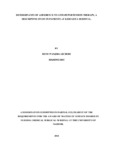| dc.description.abstract | Background:
About 1.56billion persons in the world will be suffering from hypertension by year 2025.
Hypertension is not curable but is controlled by use of anti-hypertension drugs and other lifestyle modifications. This emphasises need for therapy adherence.
Hypertension, when untreated complicates in to cardiovascular, cerebrovascular, or renal diseases hence increasing risk of morbidity and mortality. Adherence to its therapy prevents development of such complications, and hence morbidity and mortality.
Many patients with hypertension in America and in Africa who are on anti-hypertension treatment have their blood pressure not well controlled. This is blamed on patients` lack of adherence to hypertension therapy.
Non-adherence to anti-hypertension treatment is an important and often unrecognised risk factor that contributes to reduced control of blood pressure.
Objective:
This study determined adherence to anti-hypertension therapy in a cohort of patients seen at Kerugoya County Referral Hospital.
Method:
A descriptive study was conducted at Kerugoya County Referral Hospital in October and November 2017, study population being patients with a medical diagnoses of hypertension attending Medical Out-Patient Clinic.
To select study participants, purposive sampling technique was used and informed consent was sought before being included in the study. A sample size of 149 patients was involved in the study.
Structured questionnaires were used to collect data. A questionnaire contained both closed-ended and open-ended questions. It had sections on profiles of study participants, knowledge and attitude of the participants on anti-hypertension therapy, challenges faced by patients on anti-hypertension therapy, and anti-hypertension therapy adherence levels. Morisky
Medication Adherence Scale 4 items (MMAS-4) adopted from Morisky Medication Adherence Scale 8 items (MMAS-8) was used to measure medical adherence.
Data coding was done during collection to ensure accuracy during data analysis whereby SPSS version 24 was used.
Descriptive analysis of each demographic variable was done by calculating mean, mode and standard deviation for continuous variables like age and frequency distribution of categorical factors like sex and education level.
The outcomes of knowledge and attitude on anti-hypertension therapy, therapy adherence level, and the challenges faced by patients with hypertension was described and appropriate frequency distribution of responses presented using figures, bar graphs, frequency tables or pie charts.
Therapy adherence was compared between groups with a Chi-square test-Cramer`s V. Significance level was set at 0.05.
Results:
This study showed that patients with hypertension in Kerugoya County Referral Hospital`s Medical Outpatient Clinic (MOPC) had a medication adherence rate of 47.7% and adherence to lifestyle modification rate of 26.2%. Adherence to both medication and lifestyle modification was only 15.4%.
Patients with controlled blood pressure after being on anti- hypertension therapy were found to be 27.5%.
The data showed a strong and significant association between medication adherence and blood control whereby 45.1% of all patients with medication adherence had a controlled blood pressure while 88.5% of all patients with medication non-adherence had uncontrolled blood pressure..
Findings revealed a moderate and significant association between knowledge of anti-hypertension therapy and medication adherence. Respondents with adequate level of knowledge were likely to be adherent while those with inadequate knowledge were mostly non-adherent.
Participants living with spouses were more likely to adhere to medication than those without spouses. Older participants were found to adhere more to anti-hypertensive medication than the young ones.
Conclusions/ Recommendations
The reason for uncontrolled blood pressure was non-adherence to medication therapy.
Majority of the patients with hypertension in this study were non-adherent to medication therapy and also non-adherent to recommended lifestyle modification. Reasons mostly given by participants for non-adherence to anti-hypertension therapy were forgetfulness to take the required doses, high cost of medication and expensive follow-up clinics as well as unavailability of drugs in the clinic.
Intervention is needed to improve the rate of adherence to anti-hypertension therapy and ultimately control patients’ blood pressure. These include: A social support system for old and widowed patients would help improve adherence rate, especially an outreach programme or involvement of family members or neighbours in the treatment of such groups; Frequent education on hypertension and it`s management; Establishment of a cost waiver system for needy clients because they were often at risk of non-compliance due to lack of a constant supply in anti-hypertensive medication; Relevant institutions need to make anti-hypertensive drugs available in hospitals at all times to avoid incidences where patients skip medication and have to rebook appointments in order to obtain a refill.
Additional research is needed to discover the dynamics of gender, level of education, comorbidity, drug combinations and side effects on adherence to anti-hypertension therapy. | en_US |
| dc.description.department | a
Department of Psychiatry, University of Nairobi, ; bDepartment of Mental Health, School of Medicine,
Moi University, Eldoret, Kenya | |



